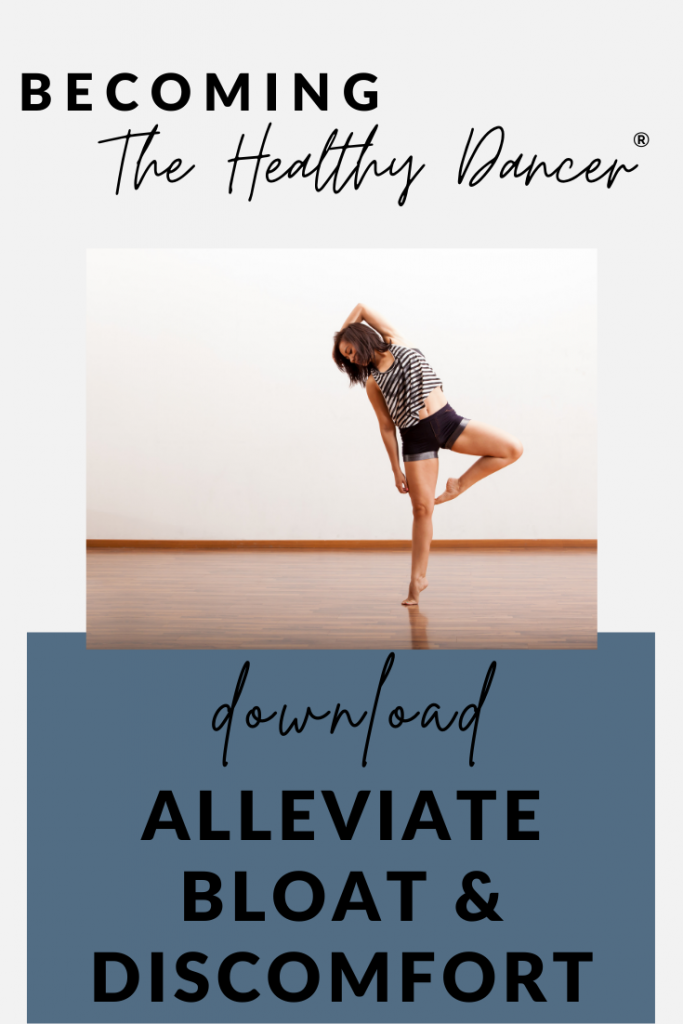“Bloat” is a feeling of discomfort that is commonly experienced alongside functional digestive disorders, which also involve symptoms like gas, constipation, and diarrhea. Functional digestive disorders are not always associated with abnormal blood tests or structural abnormalities, and can easily be misdiagnosed. IBS is one such example. Such digestive disorders should not be confused with others like colitis and Celiac Disease, both of which have clear markers for diagnosis.
Functional digestive disorders can result from a multitude of factors, some of which include eating past fullness, high levels of stress, and even long-term antibiotic use. And research shows that those who struggle with disordered eating and/or eating disorders might also be more prone to struggling with functional digestive disorders. Here are some mind-blowing stats that a fellow dietitian, Marci Evans, shared in a recent blog post:
- Up to 98 percent of people with eating disorders have digestive disorders.
- Disordered eating in itself has been shown to cause digestive issues.
- About 44% of digestive disorder patients engage in restrictive eating habits.
What else is interesting? In patients with eating disorders, specifically Anorexia Nervosa, there are apparent changes to the gut microbiome. Namely, a decrease in bacterial diversity (1). Even after treatment for an eating disorder, symptoms of functional digestive disorders often remain present (2).
Traditionally, nutritional therapy is the first line of treatment for digestive discomfort. This involves the practice of elimination diets to identify the problematic origins of the discomfort. However, eliminating any one type of food or food group can be detrimental to a dancer who is either on the road to recovery from an eating disorder or on the journey towards healing their relationship with food. According to a 2018 meta-analysis, there is evidence supporting a gluten-free diet for IBS. Therefore, solely relying on the elimination of various foods to *hopefully* “treat” the discomfort might not be the solution. Additionally, we must weigh the risks associated with the stress of disordered eating and its potential impact on exacerbating symptoms.
Don’t Confuse Fullness with Bloat
Eating past fullness is a common experience that can happen when learning how to eat in attunement to our body’s needs. Your level of fullness will shift as you nourish your body more adequately. Through trial and error, experiencing discomfort might be part of the journey when relearning how to satisfy your hunger cues. When we stop restricting our food choices, we often feel a bit fuller. It takes some getting used to. Feeling full is our body’s response to adequate nourishment. When we feel full, we know that our body has what it needs to function optimally. This is SUPER important!!
The same goes for having a distended belly after eating foods that were previously deemed “off-limits.” This physical discomfort is a very normal (and temporary) response when working through the steps toward food freedom. But there’s no doubt that diet culture has hijacked feelings of fullness after eating. We’re conditioned to feel like this discomfort means doing something “wrong.” Cue the post-meal guilt and shame.
It’s common for us to confuse this physical discomfort with being intolerant of the food. Because of diet culture messaging, we’re encouraged to adjust our eating to alleviate the discomfort. Through this “prescribed restriction” or an elimination diet can emerge disordered eating habits (a topic I dive deeper into here).
When Bloat Is A Problem
Now, I would never discredit anyone’s discomfort. Feeling physically uncomfortable is not something that should ever go unnoticed. And with the statistics mentioned above, anyone with disordered eating can struggle with functional digestive disorders. We’ll discuss some interventions soon, but if you’re experiencing additional symptoms like nausea and vomiting, then you’ll want to reach out to a trusted medical professional for additional workup.
But I heard about “leaky gut?”
“Leaky gut syndrome” (or leaky gut) is at most, a hypothetical condition that’s not currently recognized as a medical diagnosis. It’s a buzzy topic within functional medicine, and according to Mayo Clinic involves “increased intestinal permeability” that allows bacteria to “leak” through the intestinal tract. As a result, some believe a “leaky gut” to be associated with a variety of health conditions like autoimmune diseases (lupus, type 1 diabetes), chronic fatigue, arthritis, allergies, eczhema, asthma, acne, among others.
Here’s the deal: the human digestive tract is semi-permeable. In other words, this spongey membrane allows for nutrients to pass into our bloodstream. To a degree, intestinal permeability is normal and necessary for the body to access a variety of nutrients from food.
Some conditions like celiac disease, Crohn’s disease, and ulcerative colitis might increase intestinal permeability as a symptom of the disease, but whether this causes disease or other health conditions is not known. As always, elimination diets, supplements, and extreme dieting as interventions to comabt “leaky gut” not only are discouraged, but also, undermine disordered eating.
Dancers and Digestive Discomfort- 6 ways to intervene
First, if you’re being instructed to avoid common so-called “triggers” (most often described as gluten, dairy, and sugar) then I want you to raise a red flag. These are restrictions that may lead you into a rabbit hole of disordered eating. Instead, there are many ways to intervene with stomach discomfort before turning to such elimination diets.
#1: Start A Food and Mood Journal
Hint: this is NOT a food or calorie tracker. A food and mood journal helps to identify foods that trigger discomfort without fostering obsession around calories, macros, etc. Take notice of patterns – this can be a helpful indicator of not only which foods to eat throughout the day, but also of when certain foods might be less likely to cause discomfort. For example, eating cruciferous veggies minutes before class might leave you feeling gassy.
You can also identify how you’re navigating meals as a way to pinpoint discomfort. Did you eat your last meal on the go or faster than usual? Sitting down and tuning into mindful eating techniques can help. Also, fueling your body throughout the day with multiple meals and snacks to prevent prolonged periods of an empty stomach. Choosing high-volume foods (like a big ol’ bowl. of kale) might leave you physically full but not mentally
#2: Manage Your Stress
The mind-body connection becomes apparent when we examine the relationship between our brain and gut microbiome. Many refer to the gut microbiome as our “second brain.” Bottom line: a stressed mindset can mean a stressed stomach. Hypnotherapy, deep breathing, guided relaxation, and meditation are just some interventions to try.
#3: Seek Professional Support
There is research to support a potential association between mental health disorders like anxiety and depression with functional digestive disorders (and yes, disordered eating). Seeking support from a licensed mental health therapist can help. Oh, and we can’t forget that healing your relationship with food. Demoralizing thoughts around food can contribute to anxiety, which is shown to worsen stomach discomfort. A balanced approach to food supports your mental and emotional well-being.
Over-the-counter probiotics, gas-reducing medications, and digestive enzymes might also be helpful. In regards to probiotics, add fermented foods like yogurt, kefir, and sauerkraut into your daily meals (more on this here). If you’re choosing a supplement, make sure it is third-party tested. You can learn more about probiotics here.
#4: Stop Over-Exercising
Joyful movement is not the same as strenuous exercise. Overdoing the latter can direct blood away from your digestive tract. If your stomach discomfort happens after bouts of hardcore workouts, consider tuning it down a notch.
#5: Skip elimination diets
Elimination diets are not encouraged, especially since these can deprive your body’s gut bacteria of necessary prebiotic nourishment and food variety. As a reminder, prebiotics are plant-based fibers that promote the growth of probiotics (gut-friendly bacteria). Common sources of prebiotics include fruits like apples and bananas, grains, and grain-based foods. Avoiding these options (even with suspected food sensitivities) is not encouraged. When I work with dancers, I often see major improvements in symptoms once they add back a variety of foods, eat enough calories, and stress less about meals.
#6: Use Gentle Nutrition To Improve Discomfort
While eliminating trigger foods is not always the solution, many “diet-friendly” foods can cause concern. One such example is sugar alcohols like xylitol, which is commonly used in sugar-free foods. Be wary of processed fibers; they’re commonly added to “health” bars and powders labeled “high fiber.” Though not a diet food, carbonated beverages can lead to the entrapment of carbon dioxide in the gut. The result? Gas! Here are a few additional tips to consider if experiencing digestive discomfort:
- Incorporate foods high in potassium, such as tomatoes and avocados, which can help to counteract water-intention from foods higher in sodium.
- Foods with high water content, such as strawberries, cucumbers, celery, and summer squash can help to speed the passage of food that may otherwise cause constipation, gas, and bloat.
- Sprouted foods (grains, nuts, seeds, and legumes) are soaked and rinsed in a process that greatly improves their digestibility and increases nutrient availability.
- Eating cooked veggies versus raw veggies will help since the cooking process improves digestibility.
- Warm drinks like hot tea might help to alleviate discomfort. Try peppermint, chamomile, or ginger.
Lastly, in my experience working with dancers, I’ve found some foods and habits to help further alleviate bloat and stomach discomfort. For example, chewing gum regularly might result in the entrapment of air in your stomach. But it’s important to realize that our experiences are largely individual. As a result, it’s best to assess your circumstances and consult with a licensed practitioner before attempting to remove foods from your diet.
10+ Easy-Fix Solutions For Dancers to Battle Bloat
- Identify fibrous additions that can help to alleviate constipation.
- Recognize too much of a good thing: if your fiber intake becomes excessive.
- Build a more supportive hydration plan to improve gastric motility.
- Reevaluate the foods you feel worsen symptoms. Despite common thought, gluten and dairy aren’t always the culprits.
- Learn about a food-first approach to increasing the probiotics in your diet.
- Start noticing patterns and potential triggers of discomfort.
- Learn about the benefits of slowing down during your meal.
- Learn ways to alleviate stress.
- Avoid over-exercising.
- Work with a dietitian to identify other factors causing your discomfort.




